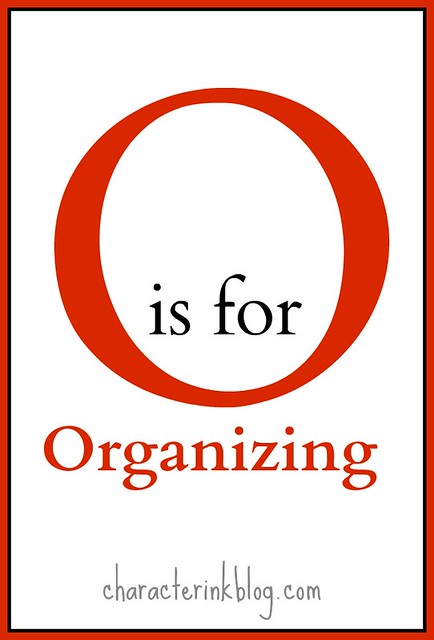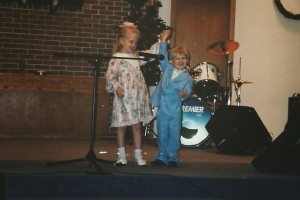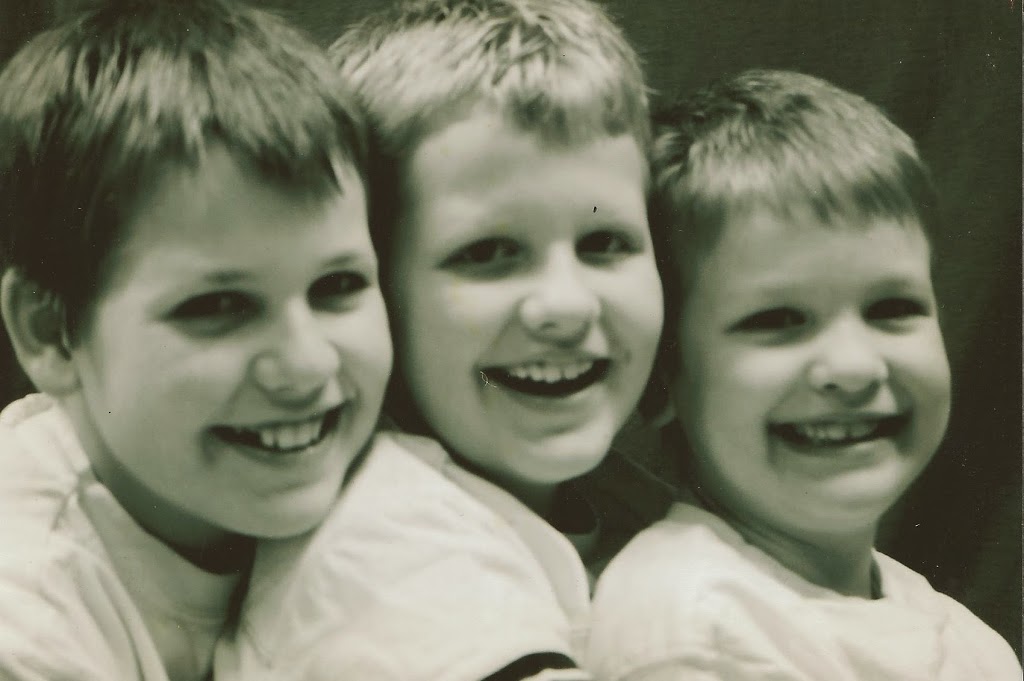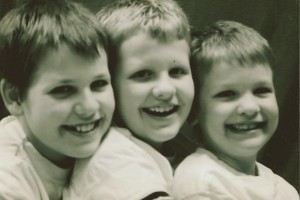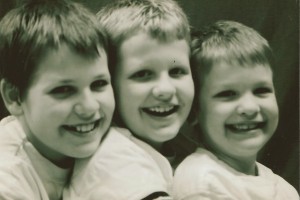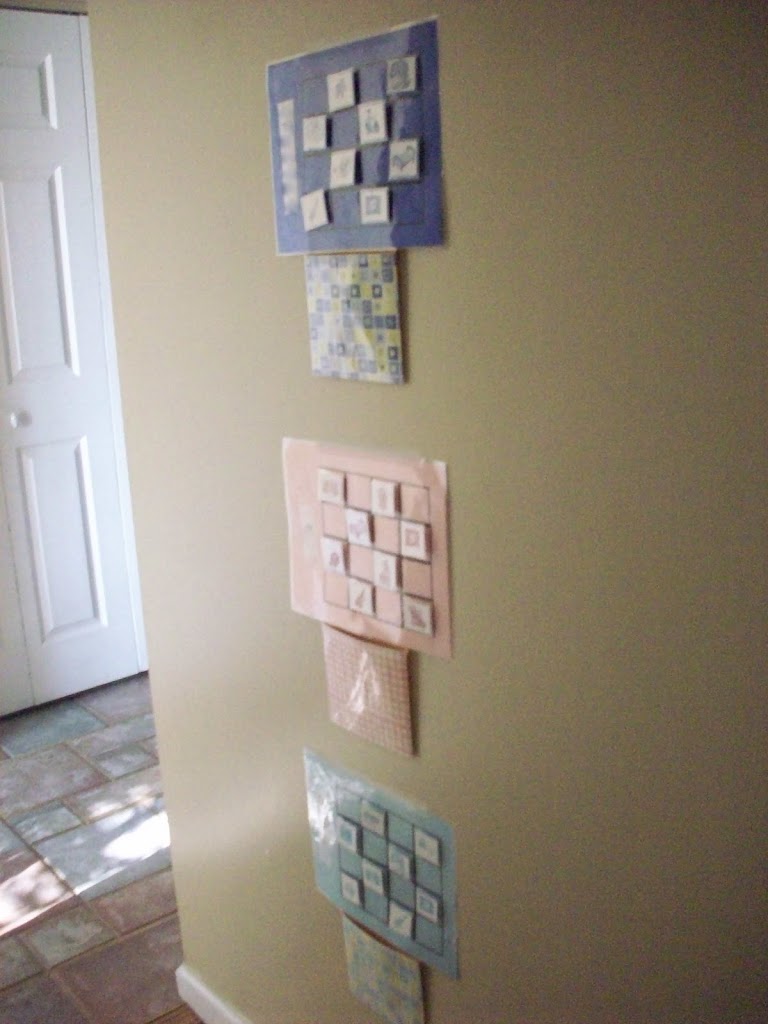by Donna | Oct 30, 2013

Besides the aforementioned “taking dictation” for a young writer (he dictates to you what he wants to write and you do the penning {or keying} for him), some simple organizational strategies can get the second through fifth grader off to a good writing start.
Here are three ORGANIZATIONAL STRATEGIES that we use in our textbooks. All three of these have the added advantage of really digging right in to the concept that a “paragraph is a unit of thought,” a crucial skill for all writers to develop.
(more…)

by Donna | Oct 22, 2013
 |
| Kara (4.5) and Jonathan (almost 3) doing their sibling Bible verse for a special at church: “How happy it is when brothers dwell together in unity!” |
The next tip after trying to set your toddler’s taste for kindness is the following: Decide ahead of time what your “behavior absolutes” are going to be.
1. These are the behaviors or negative character that you absolutely will not allow in your home. What you allow now will become the “acceptable behaviors” to your child. These seemingly innocent actions include “fibbing,” hitting, being mean to others, running the other way when called, etc.
2. For us, these “behavior absolutes” included the following:
a. Talking back (no toddler saying “no” without being punished)
b. Lying or deceit
c. Temper tantrums
d. Striking (hitting, pulling hair, throwing things at someone, etc.).
e. Being mean
Obviously, we wanted our kids to learn to obey and submit to us and to learn the many character qualities that are crucial to living a Christian life, but these five things were things we never wavered on—and things that we made huge deals out of when they were not adhered to by the toddler/preschooler.
 |
| Kara (now 23) and Jonathan (now 21) have been best friends since they were very young.–honest! 😉 |
One question we frequently get when discussing the idea of behavior absolutes is “How do we make a certain behavior an absolute?”
Before I delve into a couple specific tips for this, I do want to say that keeping sibling fighting to a minimum, helping brothers and sisters love each other, and instituting and enforcing a no striking policy is more a way of life than it is a list of do’s and don’t’s.
Obviously, we believe that there are some key things that accounted for our children’s very limited fighting and not harming each other, but more than that list of things we did is the idea of being “that family.” Not weird or trying to outdo others with our “uniqueness”–but rather our children knew that though others might fight all the time, we were”that family”–the family that doesn’t allow that. Though other children may raise their hands to harm their sibling, we are “that family”–and we do not permit hurting each other.
A way of life–one that begins with “setting tastes” for kindness and good character and one that has certain expectations always in place. Not expectations that “do this or you’re toast” but expectations that Mom and Dad taught us this way, and this is how we live.
But on to that list–a few things that we think can help a family develop certain behavior absolutes (including loving and being kind to siblings):
1. Behavior absolutes begin with a mindset.
This mindset is one with faith in what you are doing. Faith that making behavior absolutes that our children will learn to follow is what is truly best. Faith that these things that we are saying are not allowed in our home are things that God would have us do. Faith that God will bless our family’s consistency, efforts, and desire to please Him. Faith that consistency and godliness in our home really will work.
It is also a mindset that says, “What I am trying to do here is so important that I am going to put the time and energy into it that it takes to accomplish it. I am not going to let things slide that I know will cause us not to meet our goals for our children’s behaviors. I am not going to look the other way when I know something is not right. I am not going to downplay something that we have deemed as important from the beginning.”
That is a tall order. But it is one that can truly be carried out. When we go into this parenting endeavor with an idea of what we truly want our homes to look like–and the determination to follow through on it–it is very possible.
2. Your reaction to behavior absolutes being broken is crucial.
My husband has an annoying saying (it used to be; now that our kids are mostly grown, I agree with him!): “We are getting the behavior that we want. if we wanted something different, we would do something different.”
While that isn’t one hundred percent accurate, the concept is true. If we want our children to be kind to each other and not strike each other, then those behaviors have to be treated as terrible behaviors. We can’t just say, “Be nice” and hope that their behavior changes.
We liken behavior absolutes to sitting in a car seat. We can say over and over, “I just can’t get him to quit hitting his sister.”
However, we somehow (eventually) get our child to quit screaming in the car seat and sit in there until he is five or six! How is that? It is because sitting in the car seat is a behavior absolute. We would ever consider letting a child have his own way and sit up front between Mom and Dad. It is the law. It is the way it is–and it can’t be changed.
So it is with behavior absolutes. We have to feel so strongly about those behaviors that we will not budge on them. When one of our kids is mean to another one, we will not just say “Be nice” and send him to his room. We will instead respond as though he just did something very, very bad. Because if meanness is one of our behavior absolutes, it is a very, very bad thing.
I have to inject a note here about spanking–because many “modern moms” are either against it or believe that it doesn’t work. Or buy into the philosophy that spanking a child will make him mean or will make him strike others.
I know that a family of seven children is not a full-blown case study. However, I don’t see how the whole “spanking causes children to be violent” could possibly be true when all of our seven children were spanked (not carelessly; not in anger; not for frivolities or childishness) for the Four D’s –and yet they are seven of the most peaceable adults you will ever meet. As children, they didn’t often fight with each other–and seldom (if ever) struck another child (or bit, pulled hair, pushed, hit, etc.) after age two or so. (I’m sure they probably did as toddlers–but we treated it very seriously and nipped it in the bud.)
So yes, we spanked our children if they were mean or if they hurt others (as well as for other defiant behaviors). But we didn’t have to do it often. Peace with each other and not harming others was a way of life, so it didn’t take a lot of discipline for it.
Thus, the way we respond to our behavior absolutes will have a huge bearing on how “absolute” these behaviors become. Don’t take them lightly. Don’t put kids in their rooms with video games or televisions because they were unkind. Don’t tell children who hit that they shouldn’t do that–and they should be nice. Respond with the level of unacceptability that you would for something really bad–if you think it is really bad.
3. Don’t make too big of deal out of things that aren’t important.
If we truly want to develop behavior absolutes in our homes, then things that are not that big of deals can’t be made into big deals.
We see this all the time. A parent responds to a child leaving his socks on the living room floor in the same way that she responds to his backtalking or being unkind to his sister. While we recommend that the things you feel are behavior absolutes be given a high priority and level of response, we also believe that in general parents need to “lighten up” when it comes to childish behaviors (being too loud, making a mess, forgetting to pick up his socks, etc.) and focus on behaviors that are truly important (and from the heart)–such as direct disobedience, meanness, disrespect to parents and other authorities, etc.
When everything our kids do is the same level of “wrongness,” they will not learn the difference between sins and mistakes. When everything our kids do is punished in the same way, they will feel that they can never please us–that no matter what they do, we will find fault in them.
I won’t spend a great deal of time on this as we have several posts about this under the character training label and we teach about it extensively in our parenting seminar, but just examine your parenting and see if you are placing too much emphasis on the wrongness of a behavior that is just a kid being a kid and not enough on something that is coming from a child’s heart.
I will move on to older kids–including punishments that are appropriate for fighting, helping kids learn how their behaviors affect others, and teaching our kids to love and respect each other–very soon. Thanks for joining us!
 |
| And here is the sweet sibling pair when they were teens–Jonathan (17) and Kara (19). The cute thing about this pic is that it was taken when they were traveling on a summer drama team together–and they both kept it as their profile pictures on Facebook for several months. Sweet! |

by Donna | Oct 17, 2013
 |
| Yes, they really were as sweet to each other as they look in this picture–with a lot of orneriness thrown in for that little guy on the right! 😉 |
I am going to start our series with toddlers and work up chronologically. Those of you with only little kids can do some key things early on to avoid fighting and bickering between/among your children.
Two of those things are elaborated on in general (not just for fighting) in the article below, but here are some thoughts applying to the first one–SETTING YOUR LITTLE ONE’S TASTES FOR KINDNESS:
Set your little one’s tastes for kindness–in our parenting seminar, we teach about how Hebrew midwives would put a dab of date paste on infants’ tongues to give them a taste for Hebrew foods–and the verses that apply that to parenting and giving our children tastes for things early on.
We believe (and have experienced it with our seven children) that as parents we can set our children’s tastes for good things–obedience, kindness, contentment, etc.
In terms of siblings, this means that we set their tastes for loving siblings, for kindness to their brothers and sisters, etc. from toddlerhood. Here are some thoughts on carrying this out:
1. Speaking kind words to our littles
2. Hushing them when they shout, scream, say no to you or other authority or in general are harsh/not kind–NEVER let it go!
3. Using vocabulary with them from the beginning that teaches them kindness (“let kindness be on our tongues”)–words like “be nice to sissy; we love sissy” and “don’t shout at her; say nice words” and “be nice”–but not just as passing, trite phrases–more like “these are our family’s ways and words”
4. Pick the child up, hold him firmly, use wording from above, and be his external control when he has none. Don’t just take the toy and give it back and say a passing “be nice”–really take the time to give him a taste for kindness whenever he starts to show meanness. If it continues in that setting, pull him out entirely (and put him in his crib). Do not ever let meanness continue in a toddler–remember, you are setting his tastes for kindness to siblings and others.
Our daughter who is expecting a baby boy in January (her first) just said the other day, “Our little boy is going to be so cute–and sweet just like the boys were when they were little” (her younger brothers).
What makes her think that her little boy will be sweet? She knows that it is possible to set his tastes for kindness. She knows it can be done–and is going to try her best to do it. I just love that! 😉
Here is a past blog post about setting tastes and character training in toddlers.

by Donna | Oct 11, 2013
 |
| When “littles” have routines and consistency, every day can be a joy! |
Yesterday I introduced the concept of the morning routine for all children. Today I would like to spend time on helping parents develop morning routines for their preschoolers. Tomorrow I will address older children and teens in this area.
I mentioned that a mom at a parenting seminar taught us about morning routines when we only had first graders and under. As she explained developing this routine, she showed her littles’ morning routine chart—a darling “board game” that she made on half sized poster board with every other square of the “Candyland” type of board containing a picture of something that the child needed to do in the morning—a child dressed; a child making his bed; a child putting his pj’s away; etc. It was so sweet—and we came home and promptly made “morning routine board game charts” for all of our kids who were old enough to follow the board and do a morning routine. (We used little people/animals with that tacky stuff placed on the bottom of them for the child to take around the board as he does his morning routine. These boards hung on the refrigerator, so it was important that the little pieces were lightweight and stuck well when the child put them on a square.)
Here are some additional tips for implementing morning routines with your little ones:
1. Timing each activity before setting the morning routine time is more important with this age group than any other. Small children can get discouraged if things seem to take too long—and a timer and reporting back to you while developing the time for the morning routine will help him see that this morning routine is truly doable.
2. Consider making a game board like the one described above, with pictures of children on them for your non-readers. (We wrote the task at the bottom of each picture, so the child had the picture as well as the words.)
3. You know your little ones better than anybody. Only put in the morning routine what your child can truly go do fairly independently. Start out small with just a few tasks and then increase as his responsibility and diligence increase.
4. If an entire morning routine chart would overwhelm your young kids, consider an 8 ½ x 11 inch piece of tag board divided into four equal quadrants. In the upper two, put GROOM and ROOM; in the bottom two, put DRESS and MESS. Start with the upper left hand square and work towards getting that part done without complaining and dilly dallying. This GROOM one might include washing face and hands, brushing teeth, combing hair (or coming to Mom with brush and ponytail rings to have her fix your hair). Once that is well underway, add the ROOM one—and have him straighten his room and make his bed in the morning. Continue in this way until all four quadrants are part of his morning schedule. (You can laminate this and have him X each quadrant with a white board marker as he finishes it each day.)
5. Be consistent. If you say that morning routines will be done before breakfast—and before the television is turned on, then follow through. As soon as you start varying from the plan (letting him watch a cartoon when his morning routine isn’t finished, etc.), the morning routines will go by the way. He needs to see that you are serious about helping him learn diligence, responsibility, time management, obedience, and more by being consistent with his morning routine.
6. As mentioned yesterday, consider something fun, like a first-thing-in-the-morning story to get your little ones moving—then do the morning routines.
7. Only put things on the morning routine chart for this age that truly must be done in the morning. You do not want to fill the morning with so much activity that it cannot all be accomplished. Anything that can be done ahead of time, such as packing backpacks, laying out clothes, making sandwiches for lunch, etc. are better off done the night before rather than trying to cram too much into the morning.
8. Develop consistent morning routines for yourself. We can’t sit down with coffee and the morning show in our robe while expecting our children to be doing their morning routines. Modeling goes a long way in teaching thoroughness, time management, and much more.
9. Rewards and encouragement go a long way for this group!
I think back nostalgically to the days of five littles nine and under—all learning how to work, become organized, and more via morning routines. They were so proud of their morning routine game boards and would often take visitors to the fridge to show them and tell them what their early mornings consist of. Two of our little ones even did recitations at a “homeschooling expo” in which they showed their charts and told the audience what they did each morning when they got up. Wowsie…that makes me smile…with a few tears of longing mixed in.
Note: We used Choreganizer chore cards to develop our preschoolers’ morning routine charts (available at https://www.rainbowresource.com/proddtl.php?id=018244). Clip art programs would also work well for obtaining pictures to use on charts.

by Donna | Oct 11, 2013
“The most important thing that parents can teach their children is how to get along without them.” Anonymous
 |
| Image Blessed Femininity |
One of the most valuable “Proactive Parenting” tips that we have followed is that of the “morning routine” development. Twenty years ago we attended a parenting seminar in which a young mom was discussing how we could make our mornings run more smoothly, teach our children to be more independent, etc. through this thing that she called morning routines. She even had darling picture-filled charts that she made to help her non-readers follow their morning routines. We began morning routines immediately upon arriving home—and we still use them over twenty years later.
I tell moms in our workshops that “morning routines will change the way your entire day goes.” This has been true for us as a homeschooling family, but I definitely think that parents whose children need to get up, around, and off first thing in the morning would really benefit from developing these routines. If you find your mornings extra stressful—and you drop your kids off at school in less-than-happy moods as a result of the hurried, nagging-filled morning or you homeschoolers start your school day off with kids still in pajamas or carrying Lucky Charms into the school room when it’s time to begin—then morning routines are for you.
Below I will give you some tips for starting this outstanding daily habit—and in days to come, I will address various age groups and the morning routine more extensively.
1. Decide how extensive you want your child’s morning routine to be. For older kids (especially girls), we have found that it can be a full ninety minute block that includes their personal morning habits, as well as chores, devotions, and exercise. For younger children, especially boys, we have had morning routines that were simple—and called “room, groom, dress, mess”—signifying that it includes straightening their bedroom, person grooming, getting dressed, and cleaning up any messes they have from the night before (i.e. water glasses, books upstairs, making bed, etc.).
2. If your mornings are chaos now, I recommend starting with a simple list of five to eight tasks that have to be done upon rising—the most basic things that must be done. For example, getting changed, grooming, putting away pj’s, making bed, packing bag for day, etc. This can be added to later once these daily habits are established.
3. Consider what you truly have enough time for in the mornings. We are flexible with our mornings in that Mom and all of the kids stay home and do school, so we have a morning routine time, a chore time, and a personal devotion time—all before breakfast. (When our girls were home, they usually had an exercise time, as well.) If you need to get your kids out of the house early in the morning, you will not want to try to do so many things in the morning as your kids’ rising time would likely be unbearable to get all of those things in before a seven a.m. school bus trip.
4. If your children are always sleepy in the mornings—and hard to motivate, consider starting your morning ten minutes earlier, and waking them up to a story or a chapter out of a chapter book. When our boys were younger, I would sit on their bed in the morning and read to them to wake them up—then they got up and started their morning routines. This seemed to give them some time to get used to getting up and moving.
5. Be realistic in how much time everything takes. When we first set up our preschoolers’ morning routines, we used a timer and had them go do each task, then report back to us. We told them how long that activity took—and wrote down that time plus ten or twenty percent (since they will likely move more slowly in the mornings). Then we added up the total list and came up with an allotment of time for morning routines. This way both of us knew that they truly could get that little list done in that amount of time.
6. Set up consequences or rewards, depending on your parenting style. If you are having really harried mornings now, I recommend that you start out with rewards and then move to consequences. For example, you might have a jar for each child and every morning that the morning routine is completed without reminding, complaining, etc.—and on time—you put a quarter or fifty cent piece in the jar for a treat at the end of the week. After a couple of months, you could remove the reward incentive, but tell them that morning routines are still part of your day—and that if they do not do them according to the guidelines, they will lose a privilege.
The goal of morning routines is that everybody is doing what they need to do in order to start their day—without fighting, coaxing, cajoling, stress, and yelling. It is, in essence, a step toward teaching our “children to get along without us.”
*Watch this blog for future posts on morning routines at different ages and stages, chore charts, and more.

by Donna | Oct 8, 2013
“When a child is allowed to do absolutely as he pleases, it will not be long until nothing pleases him” (Anonymous).
 |
| If you don’t want your kids to get muddy, don’t let them play in the mud! But if you’re like us, and think there are many more important things in life than if kids get muddy, go ahead and let them play! The key is to be proactive–decide ahead of time what you can and cannot tolerate! |
One of our favorite Preventive Parenting tips is that of becoming a problem solver. As parents, we can complain that we do not like how something is going or how our children are behaving–or we can decide to solve the problem at hand.
We have found that many things that seem insurmountable–getting kids up and around on time in the mornings without too much stress, having the evening meal on the table at a certain time, and being sure that our kids are reading a lot–are easily taken care of when we decide to solve the problem–rather than just complaining about it or wishing that things were not as they are.
Let me give you some real life scenarios that I have recommended or heard of lately to get your “thinking skills” and “problem solving strategies” working:
1. Kids up running around in the morning, getting into things, etc., before Mom has had a chance to get herself ready–and prepare for their rising!
Make a “nobody up until you are told you can get up” rule. Our preschoolers were not allowed to get up whenever the pleased.
Just like they had to go to bed at a certain time, they also were not permitted to get up at random times. We had tape players in their bedrooms with radio dramas and talking books available–and also had them put their favorite books on their headboards. They were allowed to read or listen to tapes in the mornings, but they had to wait for me to get them up before they got out of bed.
2. Kids outgrowing their naps but fighting with each other when Mom and other littles are trying to rest.
We can come out and referee fights, yell at our kids for waking the baby, etc,. or we can make a quiet hour–a time in which only quiet activities are allowed. For us, these quiet activities were in a tub marked Quiet Hour–and were items that did not need any assistance to use.
In the case of fighting after outgrowing naps, the two who are fighting must have Quiet Hour in separate rooms–and if Quiet Hour is violated, it’s back to naps for them.
3. Kids not ready in the morning on time, stress and fighting, etc.
Implement morning routines–a set list of things that each child does from rising times until breakfast, or whatever the end of morning routine time holds. Figure up the amount of time needed to get those things done, subtract that from leaving or ready for school time–and make that time the Morning Routine time. (Read more about morning routines here.)
The point of this post is that so many things that cause us stress, fights, poor relationships, nagging, etc. can be handled through problem solving–proactive parenting–parenting in a way that we prevent those times, as opposed to always putting out fires because we did not prevent them to begin with.
Proactive Parenting provides a much more peaceful environment in our homes. It allows us to work on the discipline issues that are really crucial–and to ward off punishment, etc., for situations that can be handled ahead of time, rather than in the heat of the moment.
As an added bonus, Proactive Parenting teaches our kids how to solve problems, come up with options, get a handle on things before they become too big, etc., as they watch us model these skills for them.

